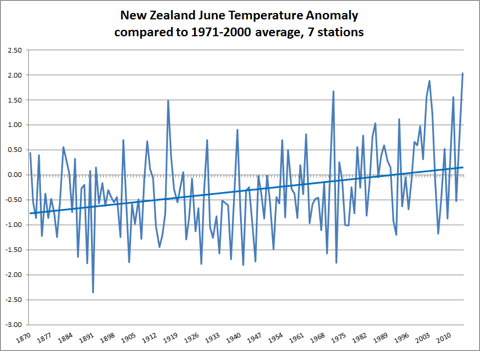
Hot off the press — or to be precise, Jim Salinger’s laptop: June 2014 was the warmest June in New Zealand since 1870, 2ºC above the 1971-2000 average, as measured by the long term “seven stations series” originally devised by Salinger and maintained by NIWA. On the larger 24 station series the month tied with 2003 at 2.1ºC above the 1971-2000 average. Many stations recorded warmest ever Junes, including Dunedin with 8.7ºC, +1.7°C above average, Invercargill with 7.8ºC (+2.2°C), Kaitaia (14.5, +1.7), Tauranga Aero (13.1, +2.4), Masterton Aero (9.8, +2.3), and Hokitika Aero (+10.4, +2.4). Jim points out that NZ warming is most clearly seen in the winter months (and expressed in the snow and ice record) but often escapes notice because a warm winter month is still “cool” compared with the seasons around it.
[Update 3/7: The Australian Bureau of Meteorology reports that the 12 months ending in June were the warmest July/June since records began (The Age. Jim Salinger tells me that in New Zealand July 13 to June 14 was the 3rd warmest in the long term record.]

 If you think it’s been a warm winter in New Zealand, you’re right. NZ is rapidly approaching the end of a record-breaking winter — the warmest for at least 150 years ((Reliable temperature records in NZ date back to the 1860s.)). Calculations by Auckland climate scientist Jim Salinger show that NZ’s average temperature for June/July/August is running at 9.5ºC, a remarkable 1.2 deg C above the 1971-2000 average, and comfortably ahead of 1998’s old record of 9.3ºC. Commenting on the numbers, Salinger notes the absence of cold snaps in recent months:
If you think it’s been a warm winter in New Zealand, you’re right. NZ is rapidly approaching the end of a record-breaking winter — the warmest for at least 150 years ((Reliable temperature records in NZ date back to the 1860s.)). Calculations by Auckland climate scientist Jim Salinger show that NZ’s average temperature for June/July/August is running at 9.5ºC, a remarkable 1.2 deg C above the 1971-2000 average, and comfortably ahead of 1998’s old record of 9.3ºC. Commenting on the numbers, Salinger notes the absence of cold snaps in recent months: There’s
There’s 